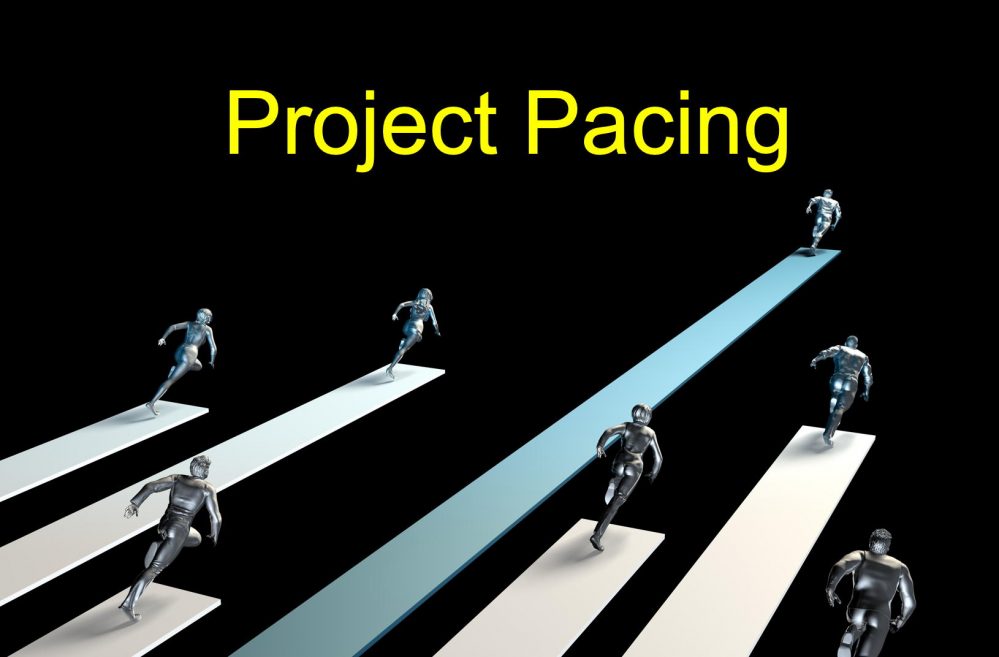Optimizing team performance is high on the priority list for most organizations, and therefore, it is well-studied. While this information seems obvious to some, especially those who have been in business for a long time, I believe it is worth revisiting. I developed the charts included in this post over the years and find that they offer a unique graphical view that I haven’t seen elsewhere. To maximize team performance, you have to manage the cadence and stress at the individual, team, and organizational level.
When you look at a team, it has a level of work rate. Large companies, in particular, strive to make that relatively uniform across business units and over time.
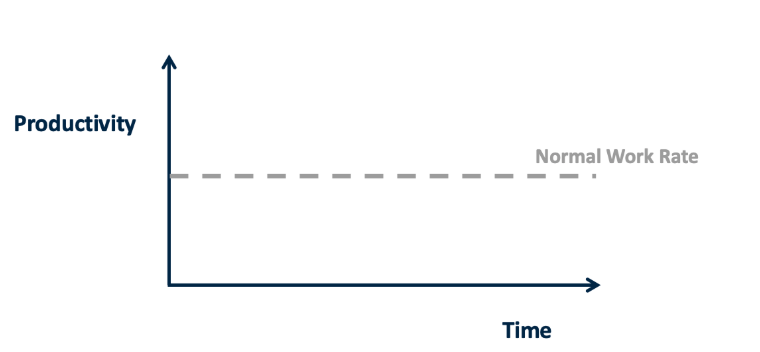
They want common work hours, universal effort, and uniform productivity levels and have systems in place to ensure this. I find that these systems lead toward average performance, though. I have especially observed this in government service.
A manager’s job is to discover ways for their team to perform better than average. If you look at it, you have a lot of people who are essentially working at a normal work rate as time progresses. The amount of work completed is the work rate multiplied by time. Productivity is the amount of work per unit of time. In the image below, the amount of work is represented by the shaded area.
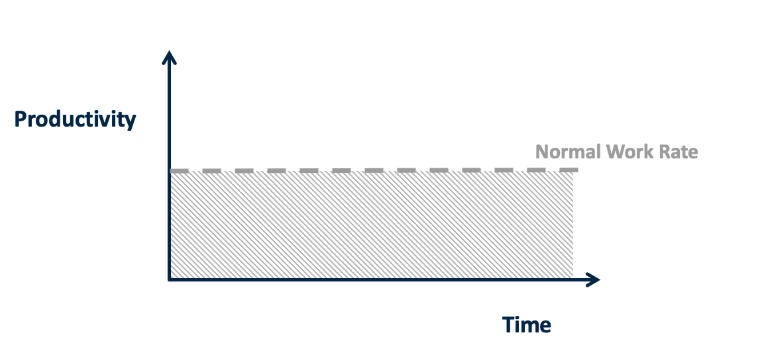
Marathon Cadence
What frequently happens is a new manager comes in and wants to increase productivity, so they raise the excitement level and inject enthusiasm over how important this project is. They motivate people to work harder, and the marathon starts.
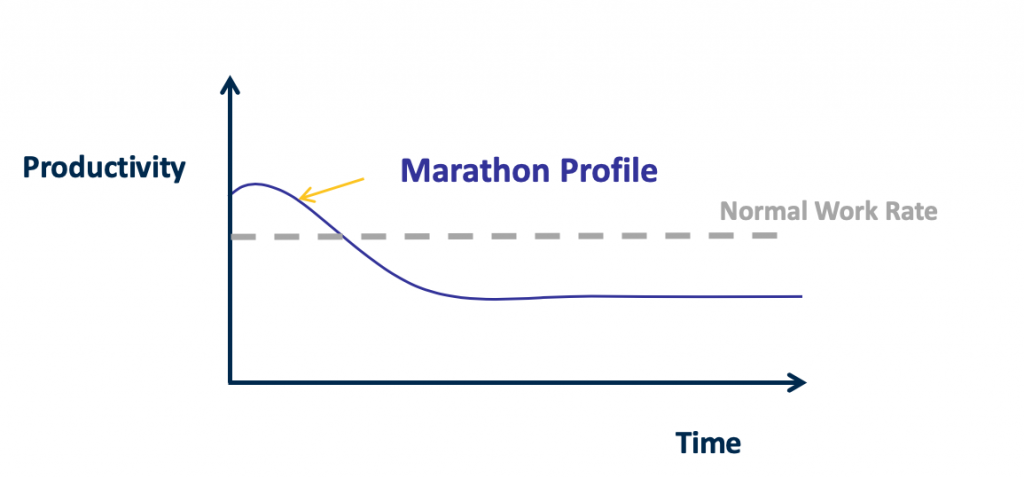
This continues for a time, but ultimately, the marathon cannot be sustained. People can’t work at an increased rate for too long before they start to burn out. The good news, however, is that the work done during that time was above the normal work rate as represented by the green area in the following image.
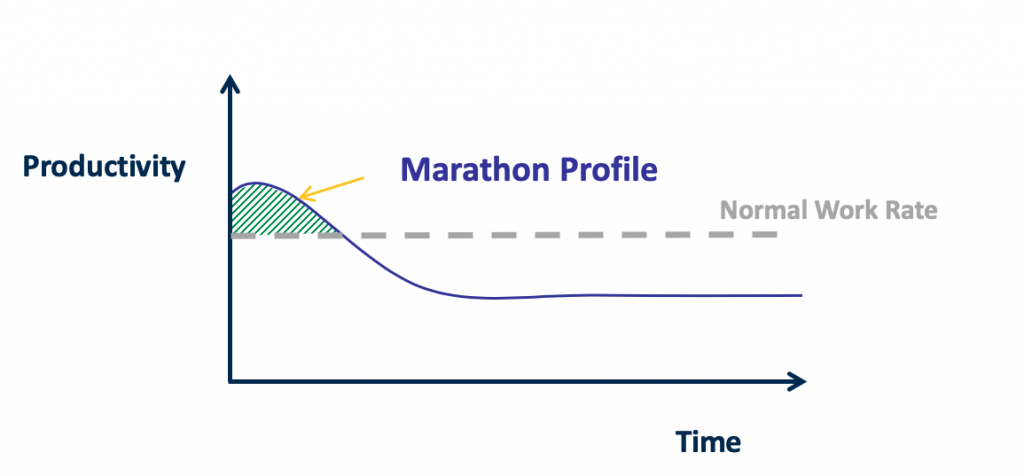
That’s good! The new manager took the reins, whipped up the team, and they produced extra work. But then it begins to taper off. The real challenge is that after the team members burn out, their productivity levels decrease, dropping below the normal work rate. It’s challenging to get back to the average level.
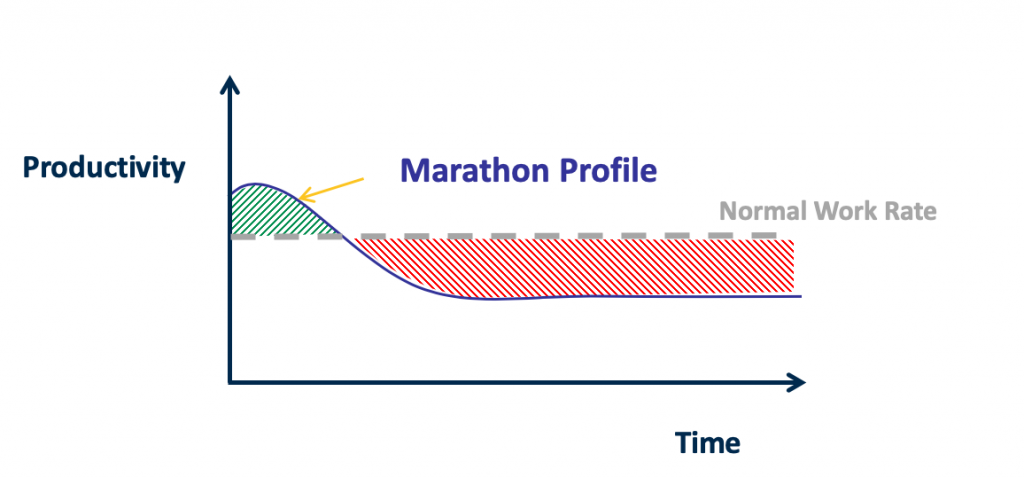
As time passes, the amount of work under the curve, represented by the red shading, becomes larger than the green area. The extra effort spent to get above and beyond the normal work rate is now erased, leading to less than average. By motivating the team to work harder, the manager actually caused a decrease in performance in the long run.
Sprint Cadence
Much of the software industry uses agile development strategies, which have now spread to other sectors. The idea is to use sprints, which are quick bursts of energy to finish projects. These are especially common in the U.S. where we like to get in, finish the job, and get out. The problem is that to maintain this, we must build in recovery time because it is not possible to conduct a sprint and then return immediately to the normal work rate or into the next sprint. Ideally, we want a development cycle that looks like this:
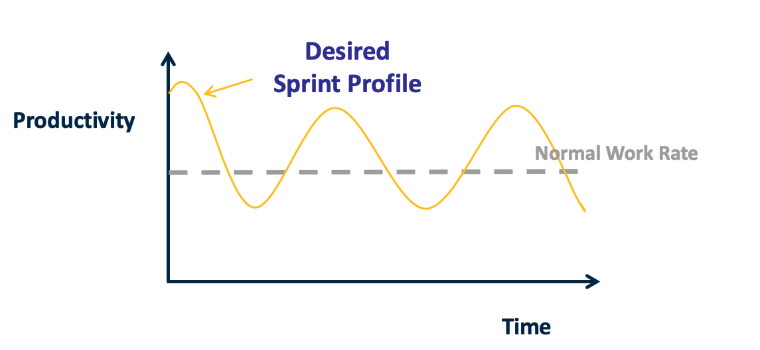
After a sprint, at least for a time, productivity drops. If we build in recovery time after each sprint, however, this approach leads to less burnout in the long run.
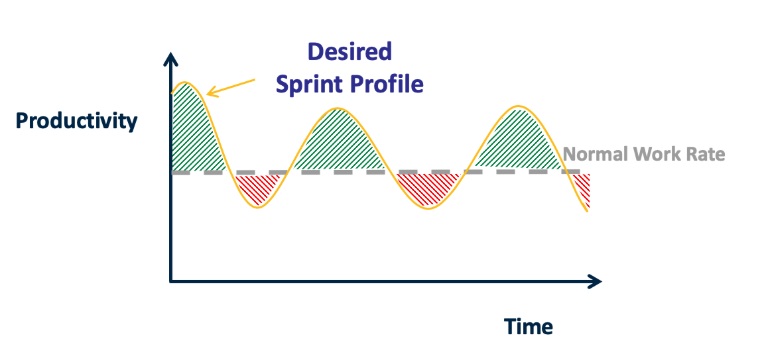
It’s clear from this image that the amount of green work exceeds the red. This process leads to higher-performing teams than a constant work rate or a marathon cadence. This extra productivity is great, but if you start a sprint and it isn’t managed correctly, such that the team only partially recovers, then the results are only slightly better than a marathon.
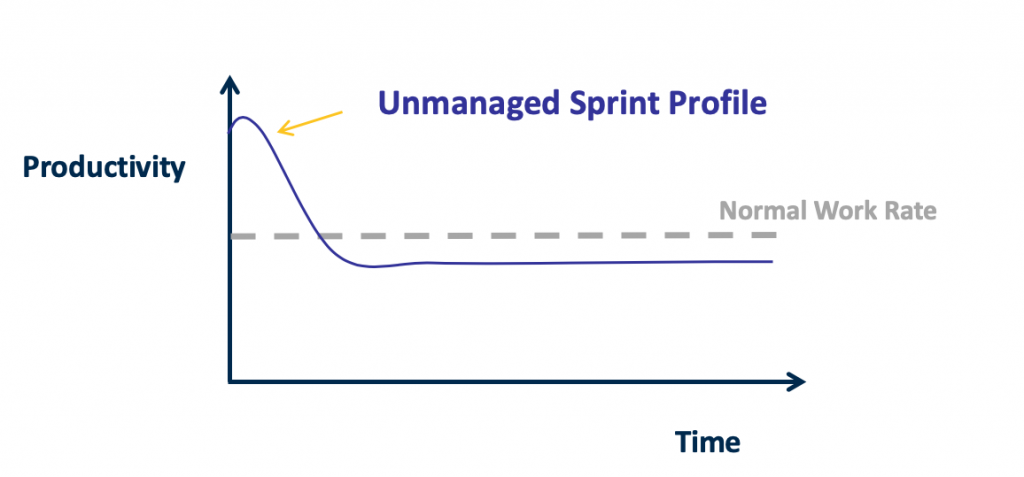
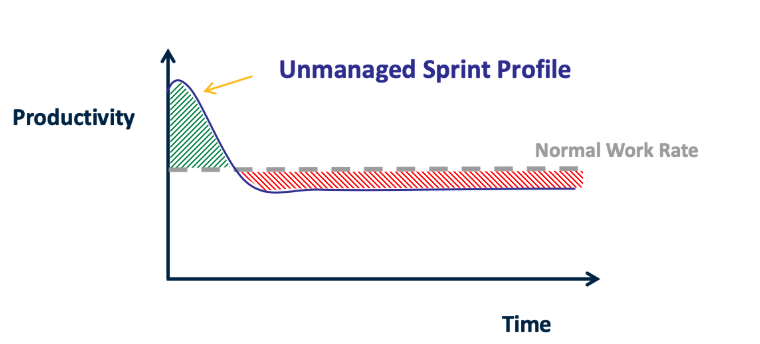
Properly Managing a Sprint
I find a better strategy is to complete a sprint, roll people off, and let them recover. Announce the next sprint, and follow the same process. Work, recover, work, recover. I also find that typically the first sprint results in slightly more work than subsequent ones, but a cadence establishes. The ultimate goal is to have the work above the normal work rate (green) be greater than the work below (red) the line, meaning higher than average performance. If you can’t maintain that, then aim for a constant normal work rate.
The Impacts of Stress
Along the same line, stress plays an important role in the psyche of the team. Psychologists have studied for decades how individuals respond to stressors. They noted that as stress levels increase, productivity increases, but at some point, it starts to fall because the stress is too high and the person can’t keep up. But note that everyone has a slightly different peak for where that level is and how much stress they can take on.
For example, in school, some students push off studying until the test or assignment nears. As they get closer to the due date, they are motivated and can really get the work done. Employees are the same way in that they have specific projects due, and they work better when they are down to the last few days to complete it. This is as opposed to plotting it out in advance and allocating the necessary time to work it in without rushing.
From a productivity point of view, that works for many people. However, when looking at this from a creativity point of view, I find the approach doesn’t work on the same time scale. People observe that when creativity enters into the equation, the peak happens sooner.
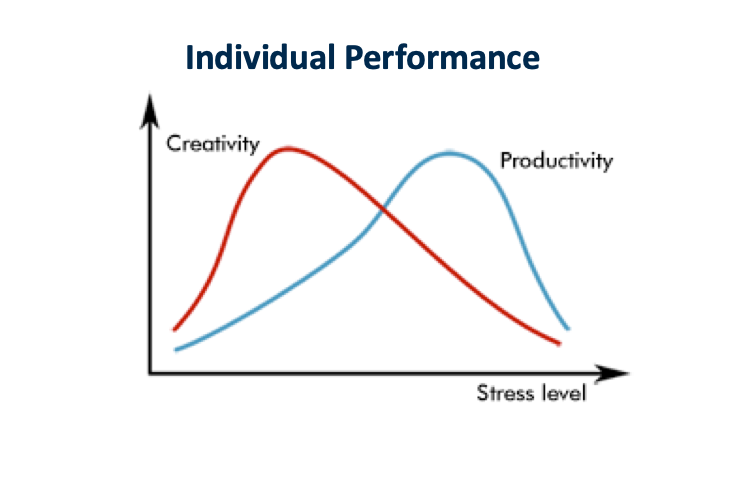
While a little stress causes a peak in creativity, it quickly tapers off, much sooner than for productivity. A little bit of stress is good. Teams should get out there, create, and innovate! But when the stress starts to feel too intense, innovation falls sooner than work output.
As a manager, it’s important to understand this at an individual, team, and corporate level. Work with employees to begin creative work sooner and find ways to reduce their stress level. If the work is merely to bang it out, then find a way to put enough stress into the equation. Think about these curves for your team and find the correct amount of stress for individuals to maximize production for your organization.
What is the appropriate level for creativity? A manager must find a way to create space for them to come up with ideas. Creativity doesn’t just happen, so one must allocate the necessary time instead of wanting it immediately. Scheduling time for innovation is hard and requires that the employee and manager work together to make it happen.
There’s a cartoon by Sidney Harris with two scientists standing at a chalkboard with several equations written on it. In the middle of the board, it says, “Then a miracle occurs.” This is the innovation step and requires time.
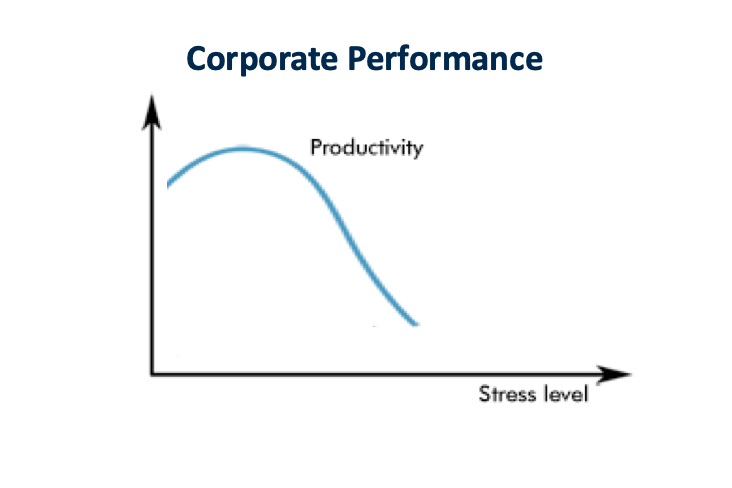
When you aggregate all the individuals, there is a corporate performance level where the organization itself has a certain level of stress. People have noticed that when you try to stress an organization in whole that the optimal stress level happens at a lower level than it does for key individuals. Still, everyone reaches their peak at a different point.
To stress the organization, the leader may say, “We have to meet this goal, and we need to do it in a month.” The key is to follow up with the performers who function better under higher stress and provide the additional motivation they need. For those who don’t perform well under pressure, ensure that they have the correct amount.
Bottom Line
To have a high-performing, optimized team, a leader must focus on the cadence of development to keep employees motivated but not burned out. Managing the stress level of individuals as well as for the organization provides a culture that includes time for innovation and creativity and an incentive for productivity.
Share this Post
